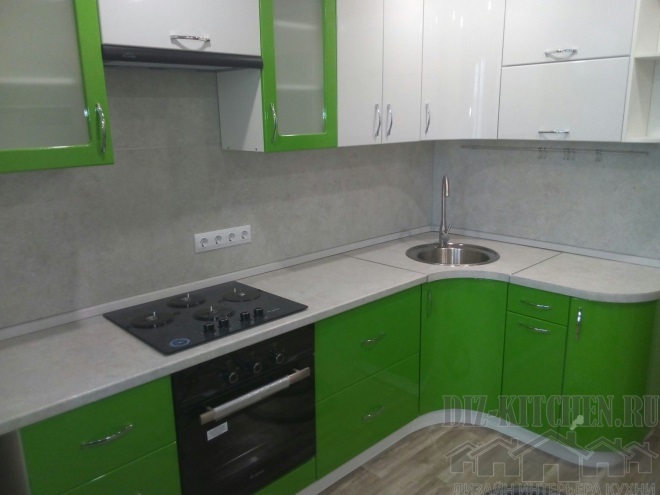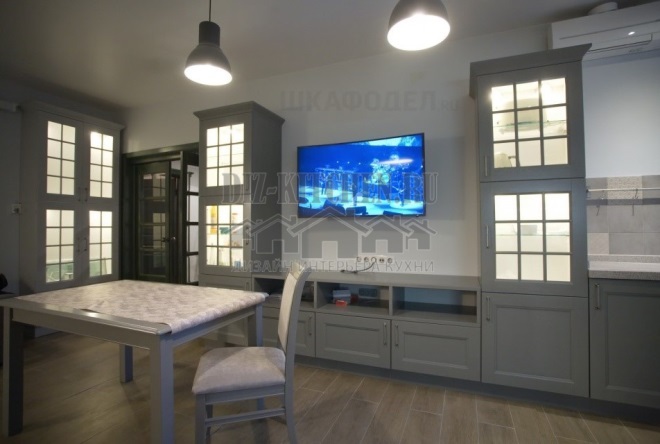Provence is a rough southern French country, saturated with the aromas of lavender, cut grass of bright green meadows (read more in this article), fresh milk and fresh homemade cakes. A kitchen made in this style will become the heart of both private houseand apartments, a place for sincere family gatherings at a large table and will turn the hours spent by the hostess preparing a family dinner into a romantic flight of fancy to the cote d'azur.
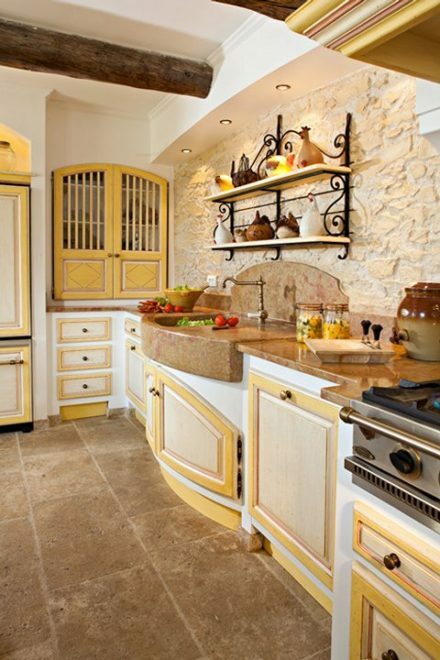
Characteristics of the interior in the style of Provence
In order to bring the attractive rustic chic into your kitchen, the main characteristics of the designs of the French provinces should be taken into account when designing it. Distinctive features:
Attention! Earned on our website kitchen designer. You can familiarize yourself with it and design your dream kitchen for free! May also come in handy wardrobes designer.
- Lack of bright colors and shades,
- Finishing with an emphasis on rugged appearance and antiquity, vintage,
- The predominance of natural materials in decoration and furniture,
- Maximum illumination,
- A large number of diverse textiles,
- Many small decorative elements,
- Mandatory presence of flowers in any form.
Following the stylistic features will allow you to recreate a unique and distinctive interior in the urban kitchen.
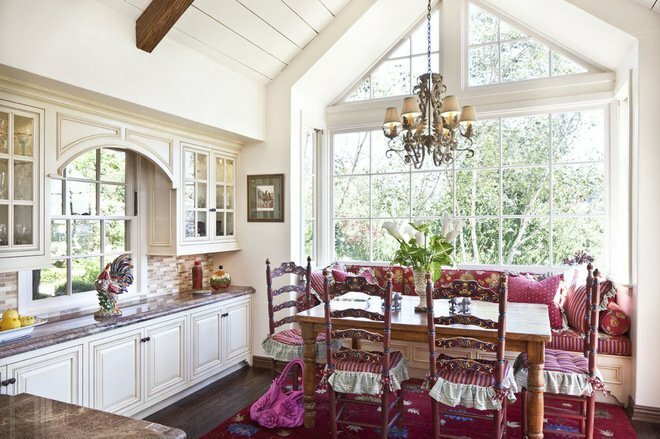
Search for a color solution
Cold minimalist or flashy-aggressive - these are the majority of modern kitchens, fully equipped with household appliances, metal and plastic. Amid this dominance of artificiality, the dining room, sustained in a Provencal vein, becomes an island of romance and a breath of clean air.
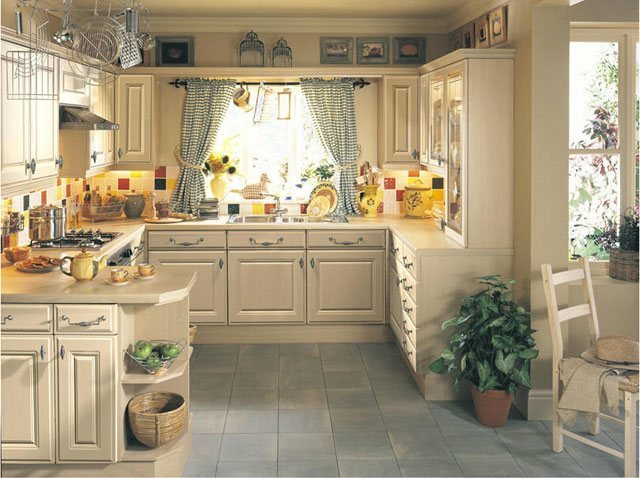
In Provence, soft pastel colors are traditionally used, akin to the natural colors of the south of France. Pure white and straw yellow (more details), muted olive, lavender, brown and terracotta, sky blue and deep blue, all creamy shades - milky, cream, ivory, champagne, beige (considered here). The variety of colors allows you to make the interior expressive without the use of bright saturated shades.

The most popular colors of this style are:
- White (more details). Pure color refreshes and expands the space, fills it with light and holiday mood.
- Blue. It occurs very often and manifests itself in everything - the solution of furniture facades, dishes and kitchen utensils, textiles. Cools the design, gives a coolness and a feeling of the closeness of the sea.
- Olive. A noble and at the same time homely color. It brings back memories of rich olive groves and a hot Provencal summer. In the interior, color is concentrated mainly on furniture facades.
- Sand. Widespread as a coloristic solution shade, the color of wheat fields, friendly beaches and hot sun. Versatile, suitable for both modest and more spacious kitchens.

Decorating the space: how to decorate the kitchen
Provence is the personification of simplicity, naturalness and natural beauty. Therefore, only natural materials are used in the decoration of the premises.
Walls
Wallpaper in Provence kitchen interiors (see also here) are used extremely rarely. The traditional solution in the design of walls is monochromatic painting (how to choose a color was spoken about here) or plastering followed by whitewashing. In this case, the texture can be either smooth or rather rough and rough. The first option is more appropriate in a city apartment, the second - in a country house. Cladding of a part of the walls with aged wooden boards, stone, brick is allowed.
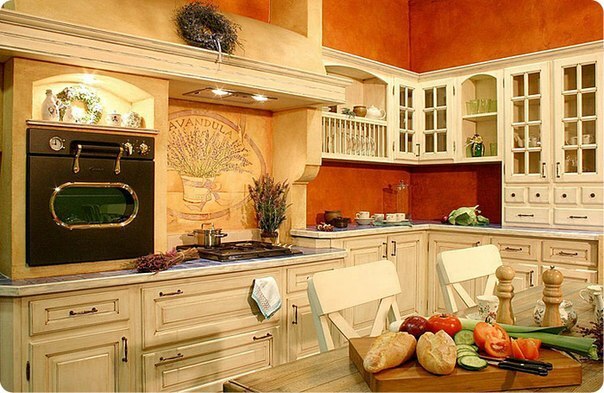
Floor
The ideal flooring solution is wood planks or ceramic imitation stone floor tiles with a matte rough surface.
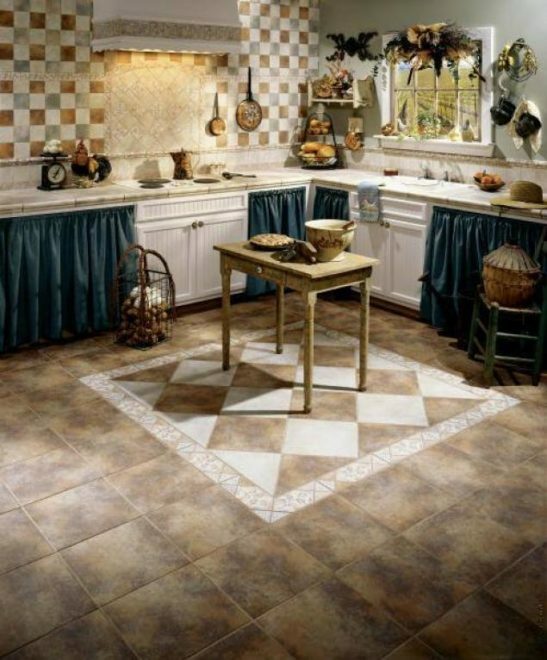
Ceiling
A universal design option is a simple whitewash (see. also this article). More complex ways of finishing the ceiling area - upholstery with painted wooden slats ("clapboard"), decoration with deliberately rough, contrasting color massive beams, creating the illusion of being in country house.
The absence of any synthetic materials (linoleum, plastic panels, stretch ceilings): there should not be glossy surfaces and sparkles in the decoration of a real Provencal kitchenette.
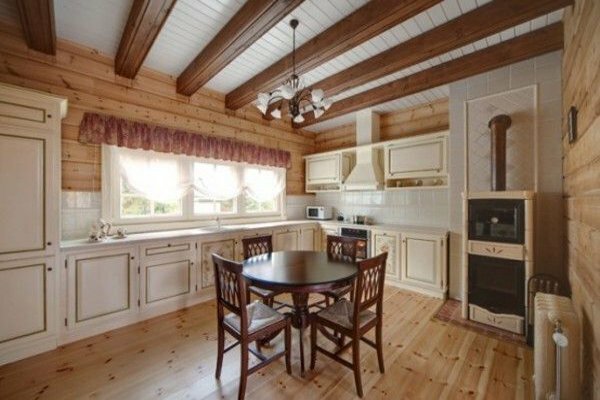
The choice of furniture for the Provencal style (photo)
The main idea of the style is fully revealed in the main element - kitchen furniture. Large sideboards with comfortable drawers, cupboards, a large dining table, wooden chairs and benches - all this will perfectly fit in the kitchen.
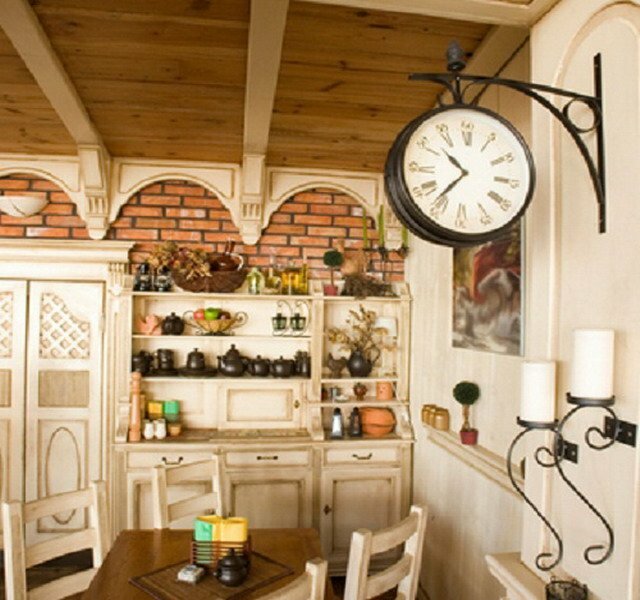
Provencal furniture is distinguished by:
- Exclusively natural material - wood (see also Kitchen decoration under a tree). It is allowed to imitate it as much as possible, painted MDF. Wicker furniture will be an interesting option. Chairs and armchairs, baskets and small tables, woven by the hands of a village master, will give the interior a special charm and comfort.
- Aged appearance. Chips and small cracks, scuffs, scratches, patina and forged or porcelain vintage fittings - if the furniture has these advantages, it will ideally fit into the Provencal interior.
- Decorative design of facades. Glass inserts, panels, carved wooden elements will add Provence style to any furniture.
- Open wall shelves or racks. A characteristic feature of the provincial style. Everything is in sight - plates and cups, various kitchen utensils are visible to the hostess and are always at hand. This ingenuous openness creates a welcoming and welcoming atmosphere.

It is impossible to imagine a modern dining room without household appliances. Stoves and refrigerators, electric kettles, toasters and other kitchen helpers should not stand out from the general style solution. They are either selected in accordance with the style features, or are hidden behind furniture facades (i.e. n. built-in appliances). It is important to consider this point even before purchasing a kitchen set.
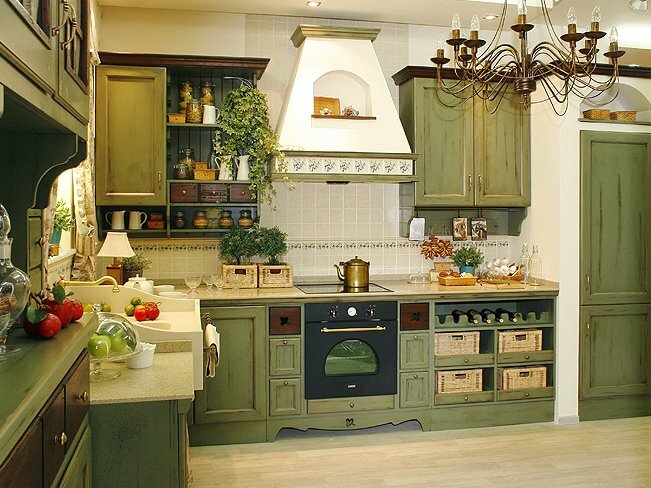
Creating textile accents
It is impossible to create the atmosphere of a rural house without the use of textile decorative elements. Provence, as a subspecies of country style, is replete with all kinds of tablecloths and pillows, towels and napkins, curtains.
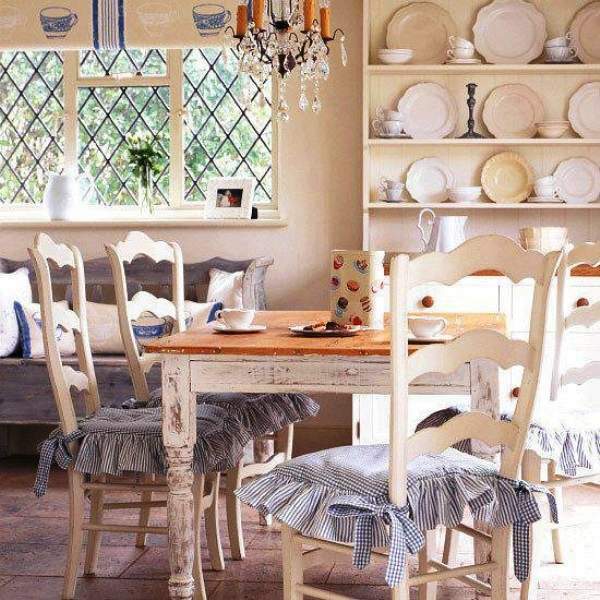
The materials for Provencal textiles are natural cotton and linen fabrics, plain or with a cute floral print, check and strip patterns. Decorating textile elements with lace and ruffles, hand embroidery is welcome.
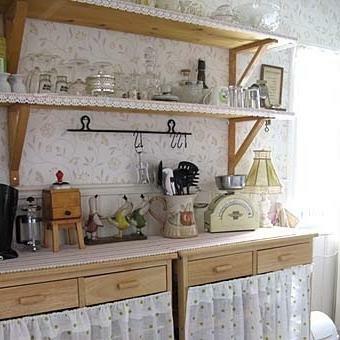
Curtains should not be dense, heavy, too lush and voluminous. A great option is light air curtains made of light translucent fabric, allowing maximum light and air to pass through.

Beauty thought out to the smallest detail
Completing the design will help filling the space with accessories that distinguish Provence from others.
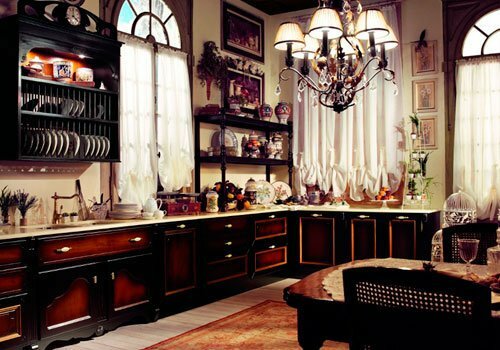
Lighting
Provencal cuisine should be well lit. Modest wrought iron chandeliers (see. also tips for choosing them) in the center of the ceiling, lamps with porcelain decorations and glass or textile lampshades, sconces and stylized candlesticks will give that abundance of light, which is typical for country houses.
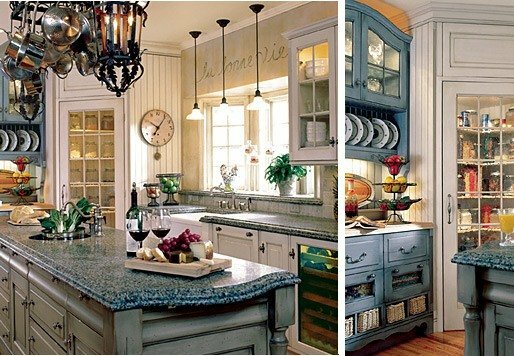
Flowers
Provence is unthinkable without a lot of fresh flowers. Lavender and peonies, sunflowers and velvet roses, fragrant rosemary and basil are everywhere - in ceramic and porcelain pots, glass bottles, enamel jugs and even shoes.
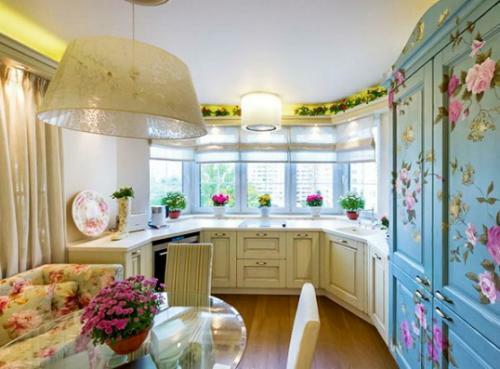
Tableware
Dishes - plates, cups - are located mainly on open shelves. It is not at all necessary that all of it constitutes one service. On the contrary, dishes of various characteristics, differing in design and material, create a feeling of a long-standing habitation of the room, adding coziness and warmth to it. It was as if the hostess had been collecting things that she liked for many years and now she decided to show her vintage collection.
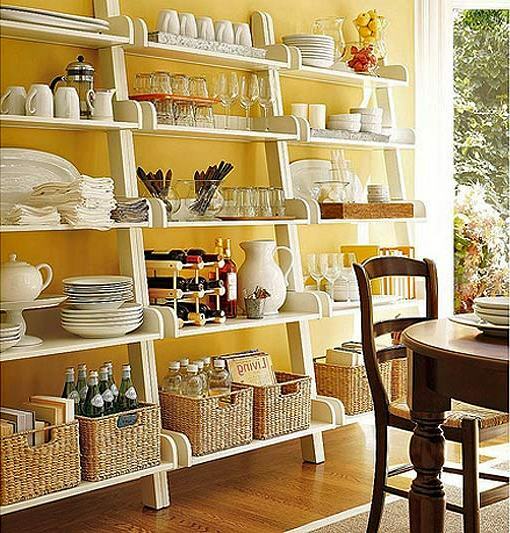
Kitchen utensils - pots, pans, saucepans, which are in plain sight, must be copper, bronze, or at least have decorations made of these metals.
The final touch will be the placement of a variety of accessories. Old cookbooks, ceramic jars with spices, elegant in their simplicity bottles with vegetable oils, and the walls will be decorated with truly rustic bunches of onions, hot peppers and garlic with cereals woven into them and dried meadow grasses.
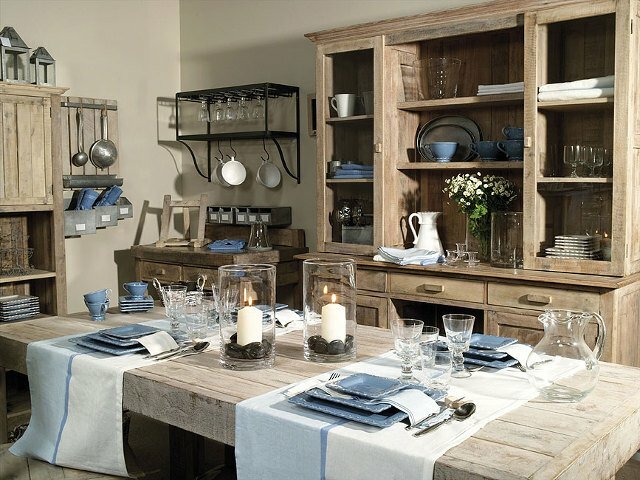
Traveling to the south of France every time you have breakfast, or preparing lunch in the middle of a lavender field, feeling the proximity of the sea and the coolness of the mistral - all this will be possible in the kitchen. The main thing is to follow the basic traditions of the style.
average rating 0 / 5. Number of ratings: 0
No ratings yet. Be the first to rate.
